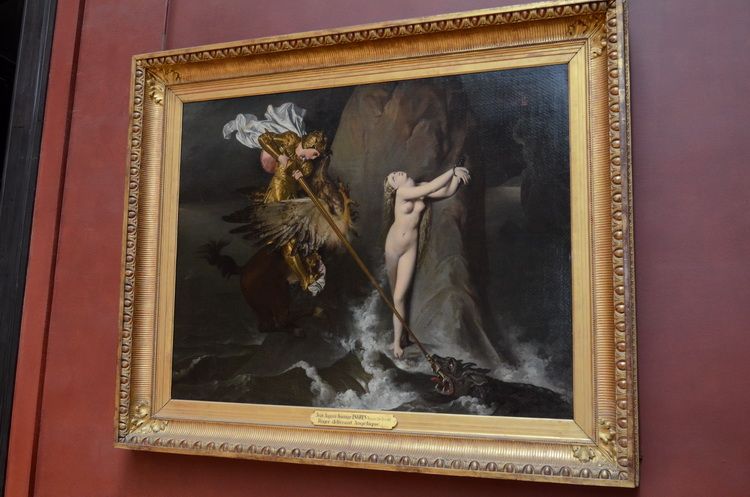Luvru + Ingres + Angelica = Un carambol cultural
 de Mihai Constantin (text/foto in Luvru)
de Mihai Constantin (text/foto in Luvru)
Ceea ce părea să fie o simplă postare a acestui splendid tablou pe care l-am remarcat la Luvru, s-a transformat în peste trei ore de căutări, lecturi și referințe încrucișate pentru a afla pretextul și contextul lucrării. Este un drum solicitant dar aducător de satisfacții care mi-a mai adus însă încă o dovadă a nețărmuritei mele ignoranțe. Acum mă macină altă întrebare: după ce am mers pe firul Boiardo-Ariosto-Ingres și o pleiada de alți plasticieni care au fost inspirați să ilustreze poemul epic din cinquecento-ul din Ferrara, văd altfel tabloul de secol al XIX-lea al lui Ingres? Am pierdut ceva din admirația frustă a compoziției plastice pentru că pot contextualiza narativ pânza? E ca și cum am învățat să citesc, înțeleg textul, dar am pierdut capacitatea de a admira formele misterioase și captivante pe care le desenează tiparul literelor pe pagină? Nu pot să-mi dau seama acum.

Oricum, pentru a rezuma un pic povestea: tabloul este ilustrarea strofelor 100-110 din cantul al X-lea din Orlando Furioso, un poem epic (adica un fel de telenovela/roman cavaleresc in versuri) scris de Ludovico Ariosto intre 1516 si 1532 cand a fost publicat integral pentru prima oara. Nu stiu cum a fost tradus in romaneste dar eu il inteleg ca “Orlando dezlantuit/furibund”. Angelica este o printesa a Orientului de o frumusete rapitoare care cam ia mintile tuturor cavalerilor de la curtea marelui Charlemagne. Orlando/Roland/Ruggier sau Rogero cum a fost tradus in diverse limbi, o salveaza la un moment dat pe Angelica tinuta captiva sub paza unui teribil monstru marin. Nici Orlando nu era chiar in fundu’ gol, avea un hibrid zburator de grifon, o pelerina smechera, o lance de mama mama, ma rog, chestii cavaleresti palpitante de secol al XVI-lea. “Laser, frate!”, cum am spune azi. M-a amuzat ca Regina Elisabeta I era atat de nerabdatoare sa citeasca opera incat l-a gonit de la curte pe cel insarcinat cu traducerea si i-a zis ca nu vrea sa-l vada inapoi fara textul terminat.
Nu stiu ce l-a determinat pe Ariosto sa scrie atata amar de vreme la acest poem. Poate pentru a combate plictiseala aristocratilor vremii. Dar cert este ca de foame nu a murit in acest timp. Ariosto se afla sub pulpana protectoare a influentei si hiperprosperei familii Este. Poate autorul a raspuns unei comenzi. Dar cert este ca Ariosto si-a facut bine treaba. Din poem rezulta ca familia Este este (sic!) descendenta lui Alexandru cel Mare si Hector al Troiei. Cred ca a meritat banii asa un pedigree.
Ariosto s-a inspirat din diverse izvoare mitologice, din istorie si a avut ca model o lucrare ramasa neincheiata, Orlando Innamorato scrisa de Matteo Maria Boiardo. Si pentru ca Italia era miezul culturii Occidentale la acea vreme, opera lui Ariosto a facut o glorioasa cariera. Inclusiv ca model pentru mai multe lucrari de arta plastica.
Aceastea o ilustratie a lui Gustave Dore la o editie de secol XIX:  Un alt moment al poemului l-a inspirat pe Bartholomeus Spranger:
Un alt moment al poemului l-a inspirat pe Bartholomeus Spranger: Apropos de referinte mitologice, Perseu si Andromeda vin firesc in minte. Si am gasit si o minunata lucrare a lui Giorgio Vasari pe tema asta:
Apropos de referinte mitologice, Perseu si Andromeda vin firesc in minte. Si am gasit si o minunata lucrare a lui Giorgio Vasari pe tema asta:
Opera lui Ariosto, prin tabloul lui Ingres, a fost folosita in 2009 de artistul libanez Mohammad Al Rawas intr-unul dintre colajele sale care l-au facut cunoscut. Sunt curios daca el stie insa cine a fost Ariosto sau daca “dialogul” sau era de fapt cu marii inaintasi Ingres si Picasso… Revenind la tabloul care m-a facut sa ma opresc pe nesfarsitele culoare si sali de la Luvru, iata si extrasul din Cantul X, o strofa in original si alte cateva in traducerea engleza:
Revenind la tabloul care m-a facut sa ma opresc pe nesfarsitele culoare si sali de la Luvru, iata si extrasul din Cantul X, o strofa in original si alte cateva in traducerea engleza: Canto 10 (st 101)
Canto 10 (st 101)
Ludovico Ariosto: Orlando Furioso
Tenea Ruggier la lancia non in resta,
ma sopra mano, e percoteva l’orca.
Altro non so che s’assimigli a questa,
ch’una gran massa che s’aggiri e torca;
né forma ha d’animal, se non la testa,
c’ha gli occhi e i denti fuor, come di porca.
Ruggier in fronte la ferìa tra gli occhi;
ma par che un ferro o un duro sasso tocchi.

XCIX
And gladly with her hands her face would hood,
Were they not fastened to the rugged stone:
But with her tears (for this at least she could)
Bedewed it, and essayed to hold it down.
Sobbing some while the lovely damsel stood;
Then loosed her tongue and spake in feeble tone;
But ended not; arrested in mid-word,
By a loud noise which in the sea was heard.
C
Lo! and behold! the unmeasured-beast appears,
Half surging and half hidden, in such sort
As sped by roaring wind long carack steers
From north or south, towards her destined port.
So the sea monster to his food repairs:
And now the interval between is short.
Half dead the lady is through fear endured,
Ill by that other’s comfort reassured.
CI
Rogero overhand, not in the rest
Carries his lance, and beats, with downright blow,
The monstrous orc. What this resembled best,
But a huge, writhing mass, I do not know;
Which wore no form of animal exprest,
Save in the head, with eyes and teeth of sow.
His forehead, ‘twixt the eyes, Rogero smites,
But as on steel or rock the weapon lights.
CII
When he perceives the first of no avail,
The knight returns to deal a better blow;
The orc, who sees the shifting shadow sail
Of those huge pinions on the sea below,
In furious heat, deserts his sure regale
On shore, to follow that deceitful show:
And rolls and reels behind it, as it fleets.
Rogero drops, and oft the stroke repeats.
CIII
As eagle, that amid her downward flight,
Surveys amid the grass a snake unrolled,
Or where she smoothes upon a sunny height,
Her ruffled plumage, and her scales of gold,
Assails it not where prompt with poisonous bite
To hiss and creep; but with securer hold
Gripes it behind, and either pinion clangs,
Lest it should turn and wound her with its fangs;
CIV
So the fell orc Rogero does not smite
With lance or faulchion where the tushes grow,
But aims that ‘twixt the ears his blow may light;
Now on the spine, or now on tail below.
And still in time descends or soars upright,
And shifts his course, to cheat the veering foe:
But as if beating on a jasper block,
Can never cleave the hard and rugged rock.
CV
With suchlike warfare is the mastiff vext
By the bold fly in August’s time of dust,
Or in the month before or in the next,
This full of yellow spikes and that of must;
For ever by the circling plague perplext,
Whose sting into his eyes or snout is thrust:
And oft the dog’s dry teeth are heard to fall;
But reaching once the foe, he pays for all.
CVI
With his huge tail the troubled waves so sore
The monster beats, that they ascend heaven-high;
And the knight knows not if he swim, or soar
Upon his feathered courser in mid sky;
And oft were fain to find himself ashore:
For, if long time the spray so thickly fly,
He fears it so will bathe his hippogryph,
That he shall vainly covet gourd or skiff.
 Bref, nu cred ca voi avea vreme vreodata sa citesc poemul lui Ariosto dar as revedea cu aceeasi mare placere si cu o emotie ceva mai educata lucrarea de la Luvru. Cam asta a fost carambolul cultural prilejuit de tabloul lui Ingres. Cert este ca Angelica a fost salvata si, sper din tot sufletul, e bine si in ziua de azi…
Bref, nu cred ca voi avea vreme vreodata sa citesc poemul lui Ariosto dar as revedea cu aceeasi mare placere si cu o emotie ceva mai educata lucrarea de la Luvru. Cam asta a fost carambolul cultural prilejuit de tabloul lui Ingres. Cert este ca Angelica a fost salvata si, sper din tot sufletul, e bine si in ziua de azi…














